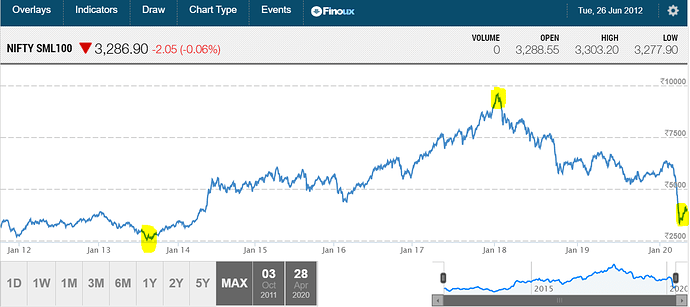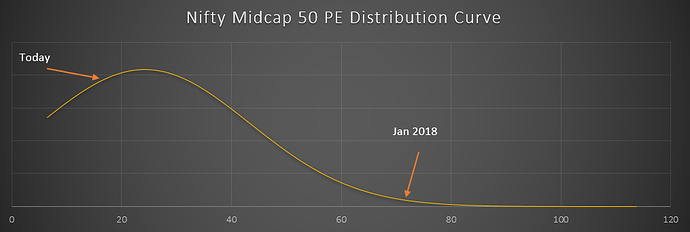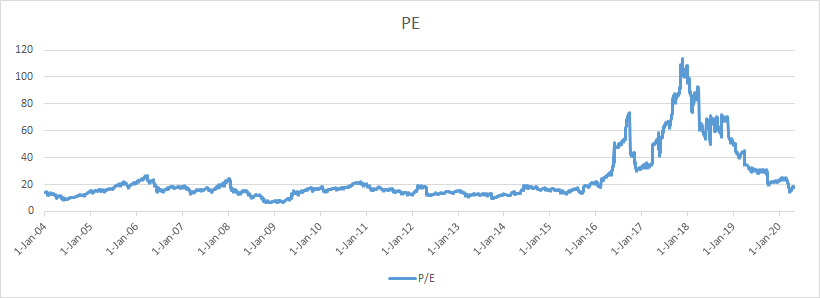As I gain more experience and go through more bear and bull cycles, I plan to slowly allocate more capital to my portfolio instead of MF.
How do you assign weights for stocks? on current value or on invested amt? Do you have any limits defined for max or min weights?
Weightage is on current value as a % of total portfolio value at present. So weightage is dynamic. I don’t follow a weightage % target per se, but try to ensure that top 3 stocks weightage should be less than 30%. However its an approx thumb rule, nothing hard and fast.
I continue to buy in bits post 2 to 3 days of consequitive corrections. Few good stocks and lumpsum in MF. Now while it’s tempting to see attractive prices, its challenging in 2 ways.
- Run out of free cash and trapped as 100% invested.
- Market bottom is unknown and it continues to sink into abyss
However, at a broad level I still believe, buying during panic still makes better sense than when there is euphoria. But catching the falling knives can cause serious injury too.
Any thoughts from members how to handle. Such situations.
Sharing some thoughts
Stick to your framework and make changes if needed . Theory is quite different and result different result when seeing through different lenses Try to ascertain why other side is buying or selling ?
Get Divorce from the stock stories stick to basic
Develop a stock exit framework … CASH IS KING … GOLD is another good asset class which rarely diminish it’s value …
And last not least wash you hands as many time as you could ![]() STAY HEALTHY Best wishes
STAY HEALTHY Best wishes
Regards
My rough framework for buying when markets are falling
- Decide on a target allocation for each stock
- Stagger your purchase and buy only those companies which are leaders in their space. When the market recovers, the leaders recover fast and also end up gaining market share. Leaders will also be survivors and will eventually give your money back. A classic example from 2008 is L&T vs Punj Lloyd (also known as Poor Man’s L&T in those times). People who bought Punj Lloyd at the market bottom never recovered their money. People who bought L&T at the peak of the bull market still made money after a few years.
- If you are not ready to see your investments go down by 10-15% every other day, postpone your purchase until the index and the markets bounce back. This would also mean that your favourite stock is now available at 30-50% more than what it was quoting at the bottom, but that is ok because you can now sleep well in the night. Just accept it and pay up the price and do not go back on your buy decision. You will never know how much further it can go up after the initial 30-50% rally.
- Raise cash by selling your mistakes - stocks that don’t deserve a place in your portfolio. Be ruthless and cut your losses and get into cash knowing that you will not hoard it and you will redeploy into quality names, preferably soon after selling your losers. Otherwise, you will end up selling low and buying high instead of selling low and buying low.
I keep a stop loss limit for each individual stock. No matter how good a stock is, stop loss is very important. Once price hits stop loss, sell first and analyze later. If required re-enter again later. Sometimes you will miss few opportunities, but you will be compensated by not having big draw downs in individual positions, plus a high chance of holding cash during bear market.
This is one of my biggest learning in almost 10 years in market after analyzing all my previous transactions. I got kicked out of almost all my positions by early March.
Do you keep a certain percentage for each stock on defining stop loss or is it a common stop loss percentage for all stocks in your portfolio? I do sell stocks when they start going down but I usually give blue chips a longer timeframe to recover.
It depends on the stock and also on my current loss/profit on the stock.
If its a new position, I have a strict stop loss of 1% of my capital. So, if I have put 10% of capital in a stock, I will have a stop loss of -10% from my buy price, so that the maximum loss at portfolio is only 1%.
If its a position where I am sitting on big profit, I am willing to be more patient and will have stop loss at say 20-30% drop from top.
Please note that I do change the limits based on the market situation. The main point is to have a loss limit and have it pre-defined for all your positions. Otherwise it is very easy to freeze in your position and become indecisive. The biggest tuition fees I have paid is in averaging down and holding on to a losing position and hoping it to recover ![]()
| S.No | Company Name | Profit/Loss % | Weightage % |
|---|---|---|---|
| 1 | ABBOTT INDIA LIMITED | 49% | 12% |
| 2 | BAJAJ FINANCE LIMITED | 8% | 11% |
| 3 | HDFC LIFE INSURANCE COM LTD | 14% | 9% |
| 4 | GMM PFAUDLER LTD | 42% | 8% |
| 5 | PIDILITE INDUSTRIES LTD | 14% | 8% |
| 6 | HDFC BANK LIMITED | -4% | 5% |
| 7 | AVANTI FEEDS LTD | -16% | 5% |
| 8 | GLAXOSMITHKLINE CONSUMER HEALT | 26% | 5% |
| 9 | BATA INDIA LIMITED | -3% | 5% |
| 10 | BERGER PAINTS INDIA LTD | 5% | 5% |
| 11 | HOUSING DEVELOPMENT FINANCE CO | 1% | 5% |
| 12 | PROCTER AND GAMBLE HEALTH LTD | 7% | 4% |
| 13 | RELIANCE INDUSTRIES | 6% | 4% |
| 14 | VARUN BEVERAGES LIMITED | -6% | 3% |
| 15 | BRITANNIA INDUSTRIES LTD | -12% | 3% |
| 16 | KOTAK MAHINDRA BANK LTD | -16% | 2% |
| 17 | ATUL LIMITED | -8% | 2% |
| 18 | P I INDUSTRIES LTD | -23% | 1% |
| 19 | MARICO LIMITED | -33% | 1% |
| 20 | ASTRAZENECA PHARMA INDIA LTD | -2% | 1% |
| 21 | ASTRAL POLY TECHNIK LIMITED | -24% | 0% |
| Total Portfolio | 8% | 100% |
Your stock selection is impressive. Market proof.
Hi
Your stock selection is nice. Have you booked any profit in Bajaj finance or abott india or gmm pflauder or you keep averaging the stocks. Just wanted to know the strategy. Overall maintaing positive returns in this drawdown is a good thing
Cheers
Shekar
It’s because two stocks ie Abbot and GM plaudier must HV bn bought at v low levels.They have substantial weightage in portfolio and around 50% profitability is able to absorb the loss of many scripts having low weighage
Very well written post by @richdreamz
An excellent mathematical approach - by @phreakv6
https://forum.valuepickr.com/t/market-meltdown-the-virus-and-our-actionables/30055/126?u=homemaker
Very nice write up by @hitesh2710
Would be great if we can get some inputs of Small Cap index PE in the last 7-8 years. With such massive correction and EPS increase over the years, my guess is small cap is in deep value zone. however this needs more data points and analysis.
source of your chart??
Hi
I dont have the smallcap NSE reported PE data but I do have the midcap 50 index data since 2004 (that is the earliest data available).
On the probability curve we are in fair valuation zone.
Rgds
Due to Covid-19 uncertainty, and a big ticket purchase , I had to liquidate my investments. Booked nominal loss in MF and satisfactory returns in Stocks portfolio. March draw-down has been extremely sharp and fast and no way I could have timed the exit. However, April bounce back from 27K to 33K in Sensex , helped recover deeper cuts. 90% in cash now and keeping a close watch on indices and learning from VP community as always !



